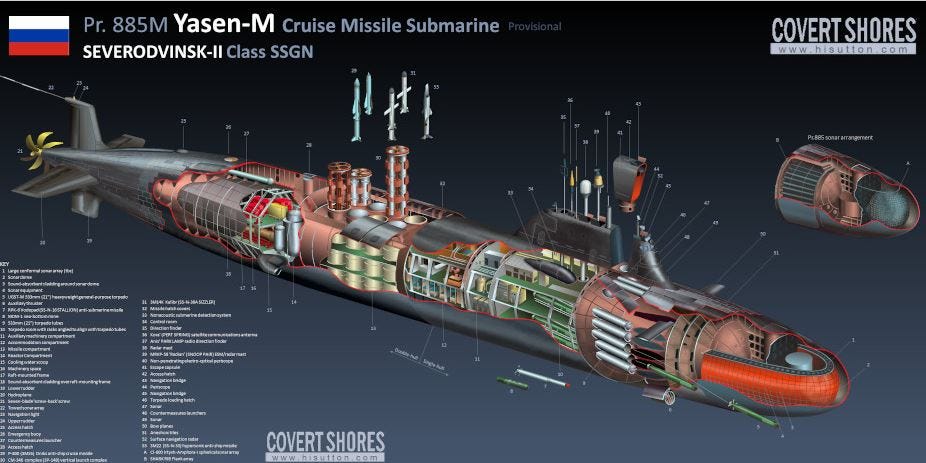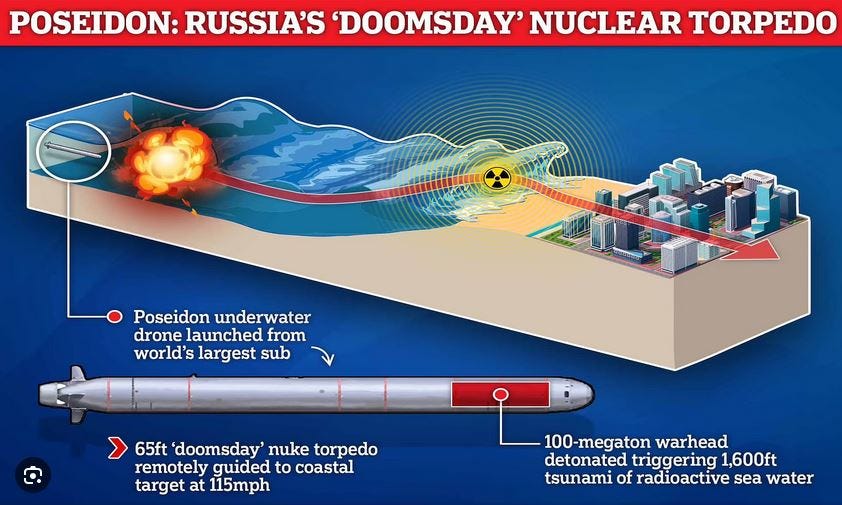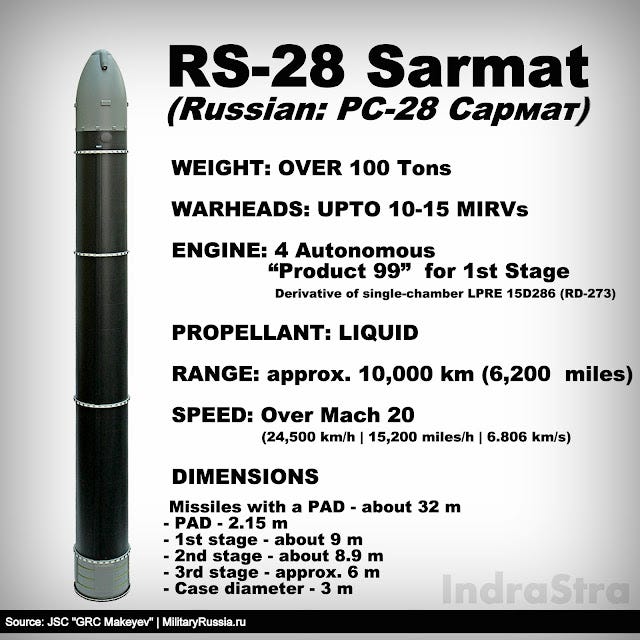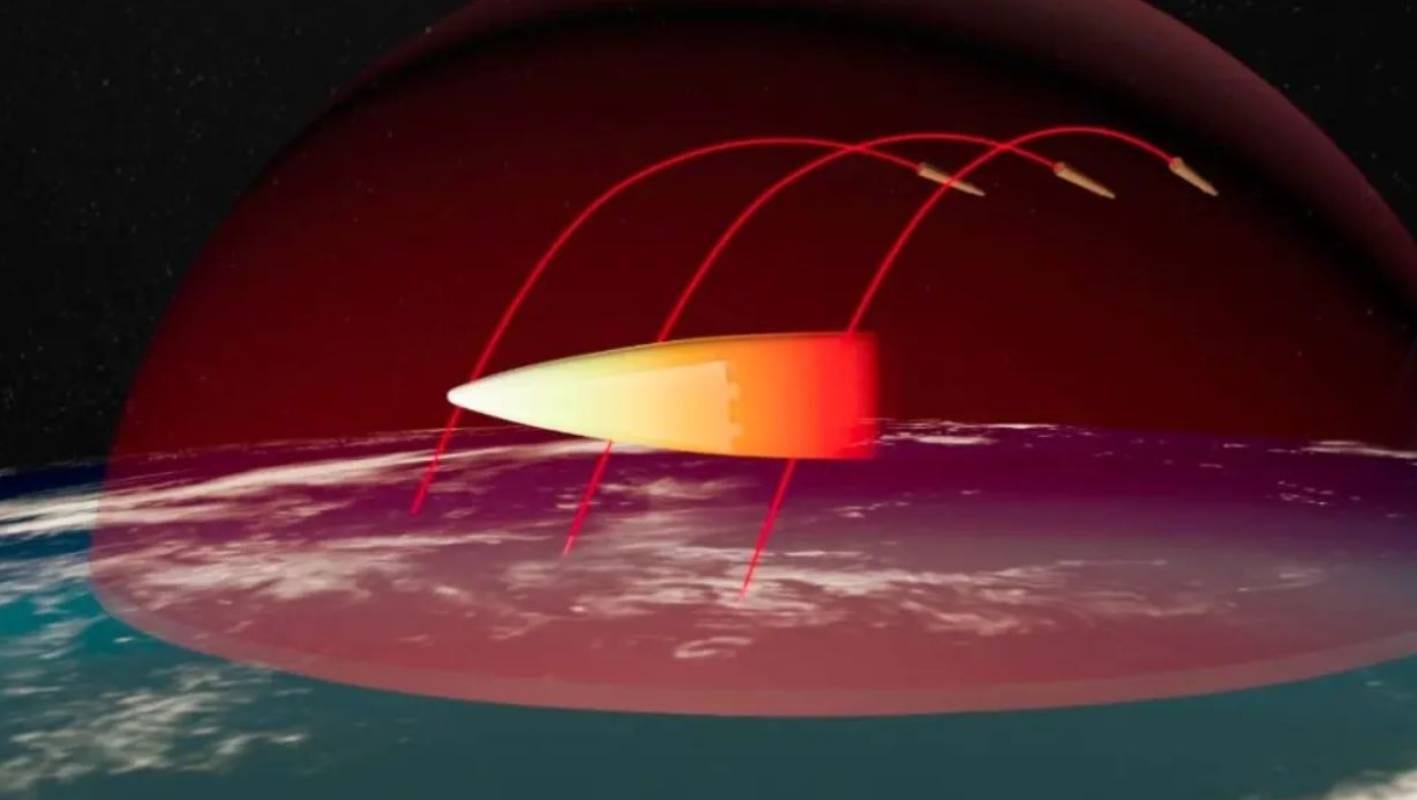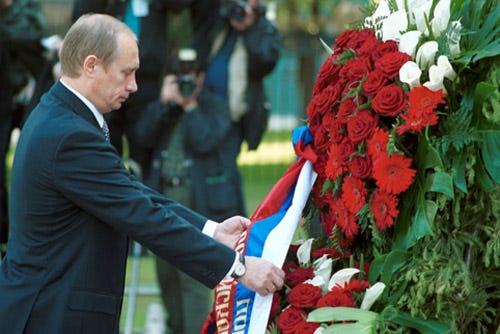Dr. Strangelove, where are you?
As I wrote previously, Russia is not really that worried about American nuclear weapons deployed from NATO bases.
Putin sees the conflict as civilizational rather than military—and nuclear war therefore cannot be high on his list of worries. After all, MAD is called that for a reason— with a first strike capability, everyone dies.
Biden may not care, of course. He's the Zombie President.
He died years ago and is kept walking and talking thanks to the brains fed to him by his advisors—no doubt culled from the bimbos who anchor for CNN. But most of us would prefer to live a little longer.
So, it's good that Putin knows what he's doing. Thanks Vlad’.
In any case, he has made sure Russia has military superiority in many of the most important areas.
The situation
Military superiority is like milk – you can use it up quickly. It can also spill.
Russia does not have really enough to go head to toe in a ring fight slugfest, but enough to make any conflict unpleasant for the other side. It could even win— but not without taking a few hits.
Fortunately, all American nuclear weapons in Europe are gravity bombs at this point—although the Americans could easily deploy missile systems.
Why haven't they?
It's not just because nuclear missile bases would be escalatory.
The US looks back nostalgically to World War II when its bomber fleets dominated the skies over Germany and Japan, accompanied by P 51s. Currently, the US has over 140 bombers, half of which are B-52s, which first flew in 1952. But most US fighter jets can carry nuclear weapons too. And it still has lots of those—including the overhyped F 35, which it needs to sell to NATO.
US bases are also show rooms for overpriced stuff they want Europeans to buy.
Looks impressive until you realize that Russia has the capability to wipe out every NATO base in Europe in a matter of hours and turn the continent into a carbonized wasteland.
Therefore, at present the real threat to Russia is not the basis but from American and British submarines and their ICBMs. But here too, the West is at a disadvantage.
All ICBMs are hypersonic—which used to be “impossible to defend against”.
“Used to be”!
The West still cannot defend against hypersonic weapons--but the Russians can!
The S550 and S500
The US develops weapons systems like it develops consumer products — there is a lot of flash—” added value” stuff of the kind that you see in each new iteration of Windows which make it look different —without actually improving anything.
The Russians by contrast focus on workability, correcting the flaws in previous systems and improving functionality. So, each "new" system is an evolutionary development. While American stuff keeps on getting more expensive, Russian weaponry just keeps getting better and better.
The S550 and S500 systems, are a good example—they build upon experience with the earlier S300 and S400 systems and hugely expand their capabilities. Overcoming limitations, they are designed to operate at longer ranges and to counter orbital and suborbital vehicles -- satellites, ICBMs, whatever that previous systems could not.
The S550 is already being deployed-- the S 500 will be in 2025. They both come with advanced new radars and networked tracking systems, capable of handling stealth aircraft.
These systems limit the West’s strike capabilities in almost every area including "first strike". As a result, Russia could survive a first strike long enough to destroy every population center in the US and Europe.
Keep in mind that in the case of fixed site operations ICBMs can take up to five minutes to prepare for launch, and prelaunch preparations are theoretically detectable. Solid fuel rockets naturally have a shorter warm-up time.
Detection is obviously much more difficult when the launch vehicle is something like a submarine or aircraft.
America used to feel secure in having Europe as the outer wall of its defenses with a network of bases threatening Russia. Kind of like classical Beijing feeling secure with the Great Wall of China.
That didn’t stop Genghis Khan in 1211. It wouldn’t stop Russia and China today!
At some point, as the Mongols proved, fixed bases can be liabilities.
A. They are static targets.
B. They offer a false sense of security.
C. They tend to end up as big boxes full of dead people.
The Cuban missile crisis
Fixed missile bases remind me of castles in the Middle Ages which were useful until cannons were invented: they are now as redundant as medieval castles became centuries ago and just as unrealistic!
In 1962, Russia and the US even came close to war about a Soviet missile base on Cuba—despite the fact that those missiles were not really a real threat to the US— since it had a four to one advantage in ICBMs and a nominal first-strike capability.
As fixed bases not far from Florida, these Cuban bases would also have been easy to take out with conventional weapons.
The American response was emotional rather than strategic: Cuba was building a castle in Florida's backyard.
But technology was already moving on.
The first launch of an ICBM from a nuclear submarine was in 1960, just two years earlier.
As mobile nuclear bases, nuclear submarines promised to render fixed bases obsolete, although in the 60s it was obvious it would take time to develop them to function effectively as weapon systems.
In any case, the Soviet missile base in Cuba was redundant before it could be built.
Now …?
That crisis was 60 years ago.
Today who knows how many Chinese and Russian submarines are lurking off the American coast?
100 underwater Cubas?
Think of the US and its northern colony, Canada, as one big island.
Looking at the map. you will see that Russia lacks the large coastal area that North America has except in the Arctic where it has no major cities but has developed its military resources, reducing the threat of attacks from NATO forces.
Russia is number one in the Arctic-- an area once ignored in the West, but now very very important.
This is one area where numbers matter. In this case, numbers expressed as infrastructure. It isn't about guns and rockets— it's about ports and icebreakers.
When the US and NATO think of numbers, they are counting their rockets, missiles, submarines, tanks and soldiers as well as bases far from their homeland.
The West had military superiority for many years especially throughout the Soviet era. These days, with a declining industrial base, that superiority is a façade. The only numbers that are really matter to the US now are the profits of military-industrial companies.
The US harks back to 1775.
By contrast, Russia is really a new country –leaner and meaner than the USSR ever was. Its industrial base continues to develop and grow. While the US graduates young people who have degraded their intelligence by studying political science, Russia graduates engineers.
As a result, the US and NATO are like a gang of big. stupid fat kids trying to bully someone smaller who knows how to fight.
Russia as number one
Russia is number one in a lot of areas – not just air defense and the Arctic— but submarine technology.
Its newest submarines are quiet and very hard to detect. Some of them, like the Yasen class, can also launch hypersonic missiles, as well as carry a wide variety of other weaponry.
While the US invested billions in developing supercarriers— which are the modern equivalent of Japanese battleships in World War II-- large targets that are pretty useless in warfare against anybody but goat herders—the Russians have developed the world's most advanced underwater killers of carriers and cities.
Not good for showing the flag of course like a carrier fleet such as we see now off the coast of Lebanon.
But one such submarine in the Mediterranean could wipe out the carrier group the US has recently sent to the region. Not that the Russians actually need submarines for this. They could manage just as easily with small ships like this (below) carrying Zircon missiles.
Or the Russians could destroy the carriers with Kinzhal missiles launched from Mig 31's as Putin has recently warned. This would apply to a carrier group in the Persian Gulf as well. Not that the Iranians necessarily need the help.
In an all-out war, Yasen class submarines’ real targets, however, are American cities such as Washington and New York which they could destroy completely in a minute and a half with missiles launched from just 150 nautical miles offshore.
What if the Americans come up with a defense against hypersonic missiles?
Unlikely, in the next five or 10 years. The US is that far behind the Russians and Chinese in air defense technologies— and with a diminishing industrial and technological base also unlikely to catch up. If they try, they will fail because by that time the Russians and Chinese will just have gotten further ahead, developing new offensive capabilities. Russia is already demonstrating it can do that.
While Americans think ahead to the next news cycle, the Russians think years in advance. They have prepared for the possibility that the Americans might become able to employ truly effective air defense systems, unlikely or not.
The Poseidon is a coastal city killer-- a nuclear torpedo designed to create a radioactive tsunami destroying coastal infrastructure.
Goodbye New York. Goodbye Los Angeles. Goodbye America
The US always considered itself safe since it was so far away from any country with the capability of mounting a close-in attack. American ICBMs and similar retaliatory systems were developed assuming attacks from the USSR with distance and delivery time big factors.
That's why Cuba was considered such a threat. To close.
But as mentioned, the North American continent is one huge island – very difficult to defend since it can be attacked from so many directions. Advanced submarines with advanced weapons make that now possible.
But there's more!
What about a weapon system that can come from any direction—say from the south – for which time and distance are not factors? One that can fly under radar?
If a Soviet base in Cuba generated Pentagon panic, this one should make the Chief of Staff soil his underwear.
Burevestnik
A weapon like this cruise missile could be launched from a submarine-- or even a cargo ship thousands of miles from its target. It can loiter for hours and hours. It’s not “clean” since its exhaust is radioactive-- but nobody cares about that in a nuclear war. Sorry Greta.
Got you worried? There’s more.
Kinzhal et al
Kinzhal is another good example of how the Russians take an old idea and turn it into something new – in this case reinventing an ICBM as Iskander and then reinventing Iskander to be launched from a variety of aircraft. The new “Dagger” has a range of up to 2000 km and can reach speeds of up to Mach 10. It is also highly maneuverable and is capable of carrying conventional or nuclear warheads.
Updated Mig 31 and Su34 high-performance fighters can both deliver it.
The advanced supersonic Tu160 can mount several. That's in addition to advanced hard to detect, hard to kill supersonic cruise missiles like the Kh32 specifically designed to attack US carrier groups and the less sophisticated P800 Oniks. apparently also supplied to Hezbollah!
Add to that the remodeled supersonic Tu22 M3M—the real workhorse Of the Russian Air Force.
Kinzhal and the Kh32 are equally effective for attacks on land targets, especially NATO bases. As a conventional weapon, the "Dagger" has the advantage of a huge amount of kinetic energy, making it possible to penetrate concrete structures, even underground—already tested and proven in Ukraine.
You can see now why Putin is taking his time in the SMO– not very worried about NATO.
Sarmat
Sarmat is the newest long-range Russian ICBM. silo launched, and capable of carrying up to 15 advanced, highly maneuverable, hypersonic warheads—plus Avangard – an innovative hypersonic glide vehicle. When the US withdrew from nuclear treaties with Russia, Russia responded.
Avangard
Avangard is a pure glide vehicle without an independent propulsion system.[22] When approaching a target, the glider supposedly is capable of sharp high speed horizontal and vertical evasive maneuvers in flight, which Russian officials claim makes it "invulnerable to any missile defence system". The blast yield of a nuclear warhead carried by the Avangard is reportedly more than 2 megatons TNT
The high speed of the Avangard likely gives it far better target-penetration characteristics than lighter subsonic cruise-missiles. The Avangard weighs about 2,000 kg and travels at Mach 20–27, giving it the equivalent of 21 tons of TNT in kinetic energy.
(Wikipedia quoting Janes)
As you can see, this weapon could be used in conventional war with a regular warhead whose explosive effect would be amplified by the missile’s high kinetic energy.
Goodbye Pentagon.
Why Ukraine is not Cuba
As I pointed out in my last article, Russia did not enter into its conflict with Ukraine, to prevent bases on its borders-- which NATO already has-- and which it is prepared for— but rather to end Western Ukraine’s war on Eastern Ukraine. As Putin has pointed out, the closer NATO bases are to Russia the more vulnerable they are to attack.
And that’s why he refuses to call the SMO a “war”.
Not that the West knows what the word"war"actually means. The US and NATO do not understand they have started a world war-- or even that they are at war at all —because they cannot imagine what a peer level war would be like other than mushroom clouds.
All that the Western military knows is wargames. Which means that “war” is just a game to them.
All the Western public knows comes from Hollywood, TV—and video games. For them, war is entertainment.
Which is why the Western media keeps on talking about the possibility of World War III happening —the ultimate bogey under the bed— even though it has already begun—like all great evils — banal.
West Point fills the empty minds of its military students not with facts but with theories of war, based on World War I and World War I —without realizing that every world war is unique to the extent that the world in which it occurs is unique.
So it is that the US lives in a fantasy world. Europe seeks to forget. Trudeau is a moron but in celebrating Nazi war crimes in the past, he highlights his support for contemporary Ukrainian and Zionist war crimes—and reveals the lost soul of Western culture.
Russia does not forget. It remembers.
Its experience is recent and bitter. For it, “never again” means something.
Putin is realistic – the ultimate pragmatist – so his primary foci are economic, legal, and cultural.
As a martial artist, he also knows it is best to avoid violence – but at the same time to be prepared for the worst. He recognizes that the US is a narcissistic bully so has created conditions of military superiority to discourage it from accidentally creating a nuclear catastrophe.
Even then, that may not be sufficient-- he must always face the fact that the US is out of touch with reality.
The guy with the buffalo horns is the true symbol of the American state.
https://julianmacfarlane.substack.com/p/russian-military-superiority



